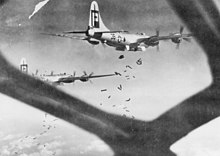|
961st Airborne Air Control Squadron
The 961st Airborne Air Control Squadron is part of the 18th Wing at Kadena Air Base, Japan. It operates the E-3 Sentry aircraft conducting airborne command and control missions. MissionProvide airborne command and control, long-range surveillance, detection and identification information for commanders in support of U.S. goals.[3] HistoryWorld War IIOrganization and crew training The first predecessor of the squadron was initially activated at Fort Douglas, Utah in January 1941 as the 61st Bombardment Squadron, one of the three original bombardment squadrons of the 39th Bombardment Group.[1][note 3] The squadron flew Boeing B-17 Flying Fortresses. While stationed at Fort Douglas, the squadron conducted flight operations from Salt Lake City Municipal Airport. In July 1941, the squadron moved with the 39th Group to Geiger Field, Washington.[1][4]  Following the Attack on Pearl Harbor, the squadron flew antisubmarine patrols off the Pacific Coast until February 1942, when it moved to Davis-Monthan Field, Arizona. At Davis-Monthan, it converted to Consolidated B-24 Liberators. With its Liberators, the squadron became an Operational Training Unit (OTU).[1] The OTU program involved the use of an oversized parent unit to provide cadres to "satellite groups"[5] It then assumed responsibility for their training and oversaw their expansion with graduates of Army Air Forces Training Command schools to become effective combat units.[6][7] The OTU program was patterned after the unit training system of the Royal Air Force. Phase I training concentrated on individual training in crewmember specialties. Phase II training emphasized the coordination for the crew to act as a team. The final phase concentrated on operation as a unit.[8] By late 1943 most of the Army Air Forces (AAF)'s units had been activated and almost three quarters of them had deployed overseas. With the exception of special programs, like forming Boeing B-29 Superfortress units, training “fillers” for existing units became more important than unit training.[9] The squadron mission changed to that of a Replacement Training Unit (RTU).[1] The RTU was also an oversized unit, but its mission was to train individual pilots or aircrews.[5] However, the AAF was finding that standard military units like the 61st, whose manning was based on relatively inflexible tables of organization were proving not well adapted to the training mission, even more so to the replacement mission. Accordingly, the Army Air Forces adopted a more functional system in which each base was organized into a separate numbered unit.[10] Most of the OTUs and RTUs were inactivated or disbanded and training activities given to these base units.[11] The 39th Group and its components were inactivated on 1 April 1944, and along with supporting units at Davis-Monthan, replaced by the 233rd AAF Base Unit (Combat Crew Training School, Bombardment, Heavy).[1][12][4][13] B-29 Superfortress operations against Japan The squadron was activated again the same day as a Boeing B-29 Superfortress very heavy bombardment squadron. When training was completed moved to North Field Guam in the Mariana Islands of the Central Pacific Area in January 1945 and assigned to XXI Bomber Command, Twentieth Air Force. Its mission was the strategic bombardment of the Japanese Home Islands and the destruction of its war-making capability.[14] Flew "shakedown" missions against Japanese targets on Moen Island, Truk, and other points in the Carolines and Marianas. The squadron began combat missions over Japan on 25 February 1945 with a firebombing mission over Northeast Tokyo. The squadron continued to participate in wide area firebombing attack, but the first ten-day blitz resulting in the Army Air Forces running out of incendiary bombs. Until then the squadron flew conventional strategic bombing missions using high explosive bombs.[14] The squadron continued attacking urban areas with incendiary raids until the end of the war in August 1945, attacking major Japanese cities, causing massive destruction of urbanized areas. Also conducted raids against strategic objectives, bombing aircraft factories, chemical plants, oil refineries, and other targets in Japan. The squadron flew its last combat missions on 14 August when hostilities ended. Afterwards, its B 29s carried relief supplies to Allied prisoner of war camps in Japan and Manchuria Squadron remained in Western Pacific, although largely demobilized in the fall of 1945. Some aircraft scrapped on Tinian; others flown to storage depots in the United States. Inactivated as part of Army Service forces at the end of 1945. Cold WarThe 961st flew radar surveillance missions along East Coast of the United States from, 18 December 1954 – 31 December 1969. The squadron assisted with the coverage of salvage operations of downed Korean Air Lines Flight 007, 1 –10 September 1983. It has served as the airborne command and control for the commander, United States Pacific Command and supported US forces counter air interdiction, close air support, search and rescue, reconnaissance, and airlift operations since 1980.[1] Operations
Lineage
Assignments
Stations
Aircraft
ReferencesNotes
Bibliography
|
||||||||||||||||||||||||||||||||||||







